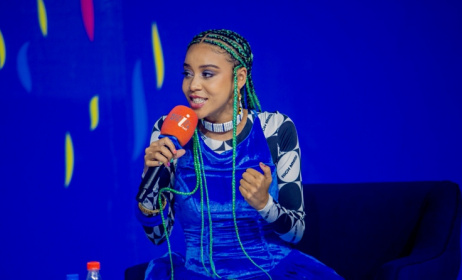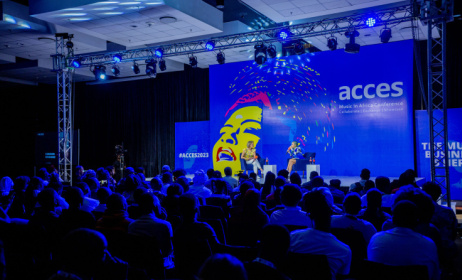Understanding music streaming royalties in South Africa
According to the International Federation of the Phonographic Industry’s Global Music Report 2021, “streaming revenue in South Africa rose 24.7% in 2020 to $32.6m [R489m], which helped offset an overall decline in recorded revenues of 2.8%”.[1] This, coupled with the news that streaming now accounts for 84% of the US music industry, underlines the importance of this revenue stream to musicians in this country and around the world.[2]
This article presents a guide to streaming royalties, including what they are, where they come from, how they are calculated and how they are split between songwriters/publishers and artists/record labels.
What is streaming?
Streaming is the practice of playing multimedia through an internet-connected device without storing the file. The media is delivered in packets, which buffer (pre-load) on the device, allowing for a seamless listening or viewing experience. Music streaming services – such as Apple Music, Spotify, Deezer, Tidal, etc. – are collectively known in the recorded music sector as digital service providers (DSPs).[3]
Like other forms of licensing and usage, streaming generates royalties for the owners of any copyrighted content that is played on these platforms, with the relevant DSP being required to pay out these royalties, often via local CMOs or aggregators.
Two types of music streaming
There are fundamentally two different types of music streaming available to consumers.
- Interactive streaming describes a service where the listener can choose what music is played at any point in time. Also called on-demand streaming, it is by far the most popular form. Globally, Spotify is the most popular streaming service. African-based DSPs include Mdundo and Boomplay, both of which focus on consumers from the African continent and are therefore prime streaming services for local music creators.
- Non-interactive streaming describes a service where the listener has no control over the music that is played. Also known as internet radio or webcasting, this form of streaming was quite popular in the early days of the internet, but it has become less prolific with the rise of interactive streaming. Popular services include Pandora, iHeartRadio and SiriusXM, with South African equivalents The Grind Radio and Bakoni Radio, as well as many terrestrial stations that simulcast online – such as SAfm, 5FM, Mix 93.8 FM, etc.[4]
How streaming works
For a song to be streamed, it needs to be distributed – in other words, ‘sent to’ – the DSPs. The sound recording rightsholder – either a record label or the original recording artist – can do this by employing the services of an aggregator, also known as a digital distributor.
- Interactive DSPs can only allow music on their stores if it is correctly licensed, as this is a private service offered by these platforms
- Not all non-interactive services accept distributed music. They are allowed to play whatever they want publicly, as long as they have paid the performing, mechanical and needletime royalties to do so.[5]
Independent labels and artists often use services like DistroKid, CD Baby, TuneCore, The Orchard or Ditto to distribute their music. These are all big international companies, though some – like Ditto, CDBaby and TuneCore – have offices in Africa. African alternatives include Africori, Music Africa, Electromode and Nazwo. Major labels – like Universal, Sony and Warner – have direct deals with the DSPs and are able to distribute their music directly in some cases.[6]
Most aggregators can send your music to hundreds of DSPs, and it is important to remember that not all DSPs are the same. The aggregator will package your music for each DSP and send it to them individually, as each DSP has its own preferences for how music, metadata and artwork should be delivered. This process takes between two and four weeks for most aggregators and DSPs, with music usually being released on Fridays – the day that DPSs, like Spotify, update their playlists and algorithm-based charts.[7]
Once the music has been released by the music streaming platforms and is publicly available, listeners can stream it to their heart’s content. This streaming usage – i.e. the amount of times a song is played on the DSPs – is what generates the royalties that flow back to the various rightsholders via the aggregators, and the performance and mechanical rights organisations (CMOs).[8]
Study Fig 1 in the PDF below to see how music is distributed and where it should be registered, in order to reach the streaming market.
Four revenue streams
Depending on where in the world a song is streamed – usually termed ‘territory’ – it can generate four different royalty payments: two for the publishers and songwriters, and two for the record labels and artists. Thanks to the Berne Convention of 1886’s reciprocity clause, each stream’s licence is subject to the laws and regulations of the country in which the stream takes place. If a South African musician’s song is streamed in Nigeria, it will generate royalties according to Nigeria’s laws and CMOs, in the same way that a Nigerian artist’s song streamed in South Africa generates the royalties discussed in further detail below.[9]
In South Africa, interactive and non-interactive streaming each generate three royalties for the rightsholder(s):[10]
- Interactive streaming (e.g. Spotify):
- Streaming royalties (paid to labels and artists via aggregators).
- Mechanical royalties (paid to publishers and songwriters via CAPASSO).
-
Non-interactive streaming (e.g. iHeartRadio):
- Needletime royalties (paid to labels and artists via SAMPRA, if the webcast is available publicly).
- Performing royalties (paid to publishers and songwriters via SAMRO).
- Mechanical royalties (paid to publishers and songwriters via CAPASSO).
1. Streaming royalties
Streaming royalties – also known as recording royalties– are paid by the DSP to the owners of the sound recording and performers’ rights. This is done by sending the money back along the same channels that the music was distributed through (see Fig 1). In most cases, this means the DSP will pay the aggregator, who will in turn pay the owner of the sound recording. In the case of major labels, the DSP will pay them directly subject to their direct agreements.[11]
These tend to be the royalties most talked about by the public and are often referred to as the ‘stream rate’ or the ‘pay-per-stream’.[12] The actual amount paid varies depending on how much a song is streamed and on the service agreement in place at the time. They are the most common royalty received by independent artists from streaming because the payment channel is relatively direct, without much additional registration or administration required.
2. Performing royalties
Any time music that is available publicly is played by a DSP to a member of the public in South Africa (even in private and via headphones), it constitutes a public performance, especially if the service is making money by playing or allowing it to be played. A service is not public if it’s blocked from being accessed, by a subscription, for example. Historically, there has been a contract with MultiChoice for the principle that the music is provided ‘publicly”. This has been a big issue since the Copyright Review Commission Report 2011.
Most DSPs do not own any of the music on their platform (they licence it from the owners), so they pay the performing royalties to the publishing rights owners via CMOs. After verifying which CMO each individual songwriter and publisher is registered with, the performing royalties are paid by the DSPs to CMOs around the world. These CMOs then pay out the royalties to their members.[13]
In South Africa, SAMRO, as the country’s official CMO, should technically collect these performing royalties from the DSPs, but since the usages are strictly private, they have an agreement in place where CAPASSO collects the royalties from DSPs then pays them on to SAMRO to distribute to its members.[14]
3. Mechanical royalties
Music streamed in South Africa also generates mechanical royalties, which are paid out by the DSP to the owners of the publishing rights.[15] Mechanical royalties from streaming are paid out similarly to the performing aspect (discussed above), with CAPASSO administering these payments in South Africa.[16]
4. Digital performance or needletime royalties
Non-interactive services, such as online radio stations that broadcast from or are based in South Africa, are required to obtain digital performance licences from SAMPRA before playing any music. SAMPRA then distributes these royalties – essentially a form of needletime royalty – to sound recording and performers’ rights owners.
How royalties from streaming are calculated and collected
The exact calculations used to determine royalties from streaming by DSPs are hidden from the public at large, due to undisclosed agreements with major labels or the complexities of the streaming business regarding indie artists. Additionally, each DSP has its own ways of calculating rates based on its individual deals with labels, DSPs and CMOs, which makes it difficult to calculate exactly how much each stream is worth.
To understand the complexities involved in this revenue stream, it is important to note the flow of money, as shown in Fig 2 in the PDF below. It starts with the listeners and the advertisers, who pay the DSPs for their services (music streaming and advertising space). The DSPs pay the different types of royalties to the aggregators and CMOs, who in turn pay the publishers, songwriters, artists and labels.
Video: This video from Raw Technique Studios provides an overview of how streaming royalties work.
The value of a stream
After the DSPs receive the revenue from their clients, they take a commission. The percentage of the commission varies between different services, but is usually between 35% and 50%.
This leaves a pool of money which the CMOs often refer to as the total distributable revenue (TDR), or the revenue available to be paid to the rightsholder(s). From the TDR, the DSPs determine the value of each stream, each doing so slightly differently, but taking the following factors into account:
1. The territory (country) in which the stream took place, including:
- The relative pricing of advertising and subscription pricing of each territory.
- The laws that determine performance royalty rates in each territory.
- The mechanical royalty rate that is set in each territory.
- The total amount of streams in relation to revenue (in each territory).
2. The type of account that the stream happened on (subscription, free, ad-supported, promotional, etc.).
3. When the stream happened (which reporting period).[17]
The per-stream rate is therefore different for each stream and on every DSP. Yet, once the DSP has calculated the value of each stream – which varied from $0.0011 to $0.01284 per stream in 2020 across the major platforms[18] – it splits up that total value of each stream into streaming, mechanical and performing royalties.[19] While a per-stream rate appears useful, Spotify prefers the idea of a ‘streamshare’, where an artist’s share of streams determines their payout. The argument is that a per-stream rate becomes diluted by increasing listener streams – in the context of a growing global audience – and ad-supported services.
The split of the performance and mechanical royalties is based on factors specific to each territory (country), which each have legislated and standardised performance and mechanical rates set by their CMOs and governments. In South Africa, there is a standard 15% allocated to these rights from the so-called end user price (EUP) – a figure that is regulated by CAPASSO and seems to refer to the proportion of the TDR payable to each artist.[20] The total split between performance and mechanical rights is as follows across the different platforms, with streaming royalties taking everything that is left over from the EUP (85%):
- Interactive Streaming: 15% of EUP
- Mechanical: 11.25%
- Performance: 3.75%
-
Non-interactive Streaming: 15% of EUP
- Mechanical: 3.75%
- Performance: 11.25%
-
Streaming Royalties: 85% of EUP
If the metadata for the composition and recording are correct, the DSPs should know who to pay and where to pay it, with payments usually coming at the end of each reporting cycle (usually one to three months). In the case of streaming royalties, the CMOs and aggregators generally receive a lump-sum payment and a usage report from the DSPs. They then use the report to split up the lump sum into individual payments for each of their respective clients and partners (artists and labels).[21]
Final thoughts
As complex as the subject of streaming royalties may seem, rights owners can follow the guidelines set out in this article to ensure that they earn as much from this important revenue stream as possible. It is important to emphasise that one of the major reasons for streaming royalties not getting to the correct rightsholder(s) is insufficient or non-existent metadata. Read our article on the importance of metadata and monitoring for more information.
Resources and citations
- [1] Eggertson, C. (2021). “RiSA Launches Official South African Music Charts Based on Streaming Data”. Billboard. Accessed on January 31, 2022: https://www.billboard.com/music/music-news/south-africa-music-charts-streaming-9624907/
- [2] Speakman, K. (2021). “Music Streaming Subscriptions Surpass 80 Million Amid Streaming Boom, RIAA Reports”. Forbes. Accessed on January 31, 2022: https://www.forbes.com/sites/kimberleespeakman/2021/09/13/music-streaming-subscriptions-hit-46-million-amid-streaming-boom-riaa-reports/?sh=39b01e481fd8
- [3] Harris, M. (2021). "What Is Streaming Music?”. Lifewire. Accessed on January 31, 2022: https://www.lifewire.com/what-is-streaming-music-2438445
- [4] Songtradr. (2017). "What You Need to Know About Streaming Royalties”. Accessed on January 31, 2022: https://blog.songtradr.com/what-you-need-to-know-about-streaming-royalties/
- [5] SAMPRA. (2021). “Tariffs”. Accessed on January 31, 2022: https://www.sampra.org.za/tariffs/
- [6] Shaw, JG. (2017). The South African Music Business (Third Edition). Billion Music: pp.75-77
- [7] https://www.wired.com/2016/08/new-music-fridays-why/
- [8] Shaw, JG. (2017). Ibid.
- [9] Matzukis, N. (2014). South African Music Law, Contracts & Business - Fourth Edition. Academy of Sound Engineering: p. 39
- [10] CAPASSO. (2021). “Documents & Forms”. Accessed on January 31, 2022: https://www.capasso.co.za/documents-forms/
- [11] Ditto Music. (2020). “How Much Do Music Streaming Services Pay Musicians in 2022?” Accessed on January 31, 2022: https://dittomusic.com/en/blog/how-much-do-music-streaming-services-pay-musicians/
- [12] Shaw, JG. (2017). Ibid.
- [13] Soundcharts Blog. (2020). “What Are Performance Royalties? (And How They’re Different From Mechanical Royalties)”. Accessed on January 31, 2022: https://soundcharts.com/blog/performance-royalties-vs-mechanical
- [14] Shaw, JG. (2017). Ibid.
- [15] Ibid.
- [16] Soundcharts Blog. (2020). Ibid.
- [17] Ditto Music. (2020). Ibid.
- [18] Fitzjohn, S. (2022). "Streaming Payouts Per Platform (+ Royalties Calculator)”. Producer Hive. Accessed on January 31, 2022: https://producerhive.com/music-marketing-tips/streaming-royalties-breakdown/
- [19] Sentric Music. (2019). "Publishing Royalties from Streaming”. Accessed on January 31, 2022: https://sentricmusic.com/blog/publishing-royalties-from-streaming/
- [20] Editor’s note: Information not able to be confirmed at the time of writing.
- [21] Soundcharts Blog. (2020). Ibid.
This article is part of the Revenue Streams for African Musicians project, supported by UNESCO’s International Fund for Cultural Diversity in the framework of the UNESCO 2005 Convention on the Protection and Promotion of the Diversity of Cultural Expressions, the Siemens Cents4Sense programme, Siemens Stiftung, Goethe-Institut, the National Arts Council of South Africa and Kaya FM.
Editing by David Cornwell and Kalin Pashaliev




























Commentaires
s'identifier or register to post comments